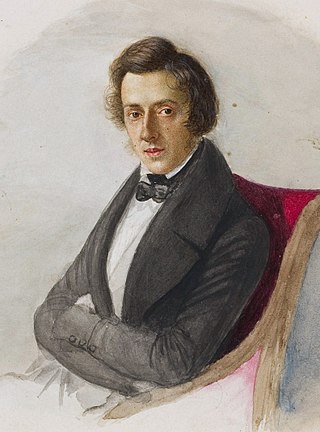A nocturne is a musical composition inspired by, or evocative of, night.
Contents
- Art
- Film
- Music
- Classical compositions
- Albums
- Songs
- Television episodes
- Video games
- Other uses
- See also
Nocturne may also refer to:
A nocturne is a musical composition inspired by, or evocative of, night.
Nocturne may also refer to:

A nocturne is a musical composition that is inspired by, or evocative of, the night.
A fantasia is a musical composition with roots in improvisation. The fantasia, like the impromptu, seldom follows the textbook rules of any strict musical form.

Frédéric Chopin's Fantaisie-Impromptu in C♯ minor, Op. posth. 66, WN 46 is a solo piano composition. It was composed in 1834 and published posthumously in 1855 despite Chopin's instruction that none of his unpublished manuscripts be published. The Fantaisie-Impromptu is one of Chopin's most frequently performed and popular compositions.

Raoul Armand Jerzy (von) Koczalski was a Polish pianist and composer. He also used the pseudonym Georg Armand(o) Koczalski.

Selim Gustaf Adolf Palmgren was a Finnish composer, pianist, and conductor. Palmgren was born in Pori, Finland, February 16, 1878. He studied at the Conservatory in Helsinki from 1895 to 1899, then continued his piano studies in Berlin with Ansorge, Berger and Busoni. He conducted choral and orchestral societies in his own country and made several very successful concert tours as a pianist in the principal cities of Finland and Scandinavia, appearing also as a visiting conductor. In 1921, he went to the United States, where he taught composition at the Eastman School of Music, later returning to Finland, where he died in Helsinki, aged 73. Palmgren was married to the opera singer Maikki Järnefelt from 1910 to her death in 1929.
C minor is a minor scale based on C, consisting of the pitches C, D, E♭, F, G, A♭, and B♭. Its key signature consists of three flats. Its relative major is E♭ major and its parallel major is C major.
G minor is a minor scale based on G, consisting of the pitches G, A, B♭, C, D, E♭, and F. Its key signature has two flats. Its relative major is B-flat major and its parallel major is G major.
F-sharp minor is a minor scale based on F♯, consisting of the pitches F♯, G♯, A, B, C♯, D, and E. Its key signature has three sharps. Its relative major is A major and its parallel major is F-sharp major.

Andrei Gavrilov is a Russian-Swiss pianist.
Sparky's Magic Piano is the second in a series of children’s audio stories featuring Sparky, an original character created for Capitol Records in 1947. Sparky is a boy with an overactive imagination. His adventures involve inanimate objects which magically come to life and talk to him.
A ballade refers to a one-movement instrumental piece with lyrical and dramatic narrative qualities reminiscent of such a song setting, especially a piano ballade. In 19th century romantic music, a piano ballad is a genre of solo piano pieces written in a balletic narrative style, often with lyrical elements interspersed. Emerging in the Romantic era, it became a medium for composers to explore dramatic and expressive storytelling through complex, lyrical themes and virtuosic techniques.

Dumka is a musical term introduced from the Ukrainian language, with cognates in other Slavic languages. The word dumka literally means "thought". Originally, it was the diminutive form of the Ukrainian term duma, pl. dumy, "a Slavic epic ballad … generally thoughtful or melancholic in character". Classical composers drew on the harmonic patterns in the folk music to inform their more formal classical compositions.

Peter Roy Katin was a British classical pianist and teacher.

The Nocturnes, Op. 27 are a set of two nocturnes for solo piano composed by Frédéric Chopin. The pieces were composed in 1836 and published in 1837. Both nocturnes in this opus are dedicated to Countess d'Appony.

The Nocturne No. 20 in C♯ minor, Op. posth., Lento con gran espressione, P 1, No. 16, KKIVa/16, WN 37, is a solo piano piece composed by Frédéric Chopin in 1830 and published in 1875.
The Nocturne in E minor, Op. posth. 72 No. 1, WN 23, was composed by Frédéric Chopin for solo piano in 1826. It was Chopin's first composed nocturne, although it was the nineteenth to be published, in 1855, along with two other early works: a funeral march in C minor and three écossaises. The composition features an unbroken line of quaver triplets in the left hand set against a slow melody of minims, crotchets, quaver duplets and triplets. It consists of 57 bars of common time with the tempo given as Andante, = 69 bpm.
Nocturnes are musical compositions inspired by, or evocative of, night.

Frédéric Chopin's output mostly consists of pieces for solo piano. There are also the two piano concertos, four other works for piano and orchestra, and a small amount of chamber music. However, Chopin also produced a number of other compositions, mostly for solo piano, but some for other forces. Some of these are well-known, such as the Barcarolle in F-sharp, the Fantaisie in F minor, the Berceuse in D-flat, and some of the 19 Polish songs. Most of the other lesser-known works were published only after his death, contrary to his express wishes that all his unpublished manuscripts should be burned.